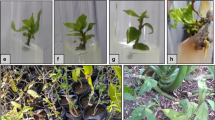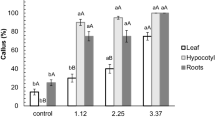Abstract
Trichopus zeylanicus subsp. travancoricus (known as Arogyapacha), an endangered ethnomedicinal plant of the Western Ghats of South India, serves as the major source of the commercial drug Jeevani. The present study established a long-term high frequency in vitro propagation protocol for Arogyapacha. Callus obtained from the branch–petiole explants cultured on Murashige and Skoog (MS) medium with 4.5 μM 2,4-dichlorophenoxyacetic acid upon subculture to medium with different concentrations of 6-benzyladenine (BA) either alone or in combination with an auxin favoured shoot morphogenesis. Medium with 13.3 μM BA alone facilitated high frequency shoot bud (mean of 93.2) formation. Medium with lower concentrations of BA (4.4, 6.6 and 8.8 μM) alone or in combination with lower concentration of α-naphthaleneacetic acid (NAA) or indole-3-butyric acid (IBA) favoured better shoot growth than 13.3 μM BA containing medium, but with reduced number of shoot buds. Subsequent cultures on medium with lower concentrations of BA and also on MS basal media facilitated shoot formation as well as growth of shoots. The shoot regeneration potential showed no decline up to 5 years. Culture of the in vitro-derived whole branch–leaf explants on MS basal medium developed shoots directly from the node. On medium with 19.6 μM IBA, the whole branch–leaf explants induced nodular callus from the node, which developed shoots later. Subsequent cultures on medium with BA exhibited high frequency shoot formation. The transfer of shoots after 10–15 days culture on half-strength MS medium containing 2.7 μM NAA to half-strength basal medium induced a mean of 11.3 roots. Field survival of plantlets relied on the soil mix: a 1:4 ratio of sand and red-soil exhibited the highest plantlets survival (86.6%). RAPD profile of the source plant and plants regenerated from calli after 4 years showed no polymorphism. The established plantlets with morpho-floral features similar to that of the source plants flowered normally and set fruits.




Similar content being viewed by others

References
Anilkumar ES, Dan M, Navas M, Rajasekharan S, Pushpangadan P (2002) Pharmacognostic studies on Trichopus zeylanicus ssp. travancoricus. J Trop Med Plants 3:239–246
Berthon JY, Boyer N, Gaspar T (1987) Sequential rooting media and rooting capacity of Sequoiadendron giganteum in vitro. Peroxidase activity as a marker. Plant Cell Rep 6:341–344
Dellaporta SL, Wood J, Hicks JB (1983) A plant DNA minipreparation. Version II. Plant Mol Biol Rep 1:19–21
Evans DA, Subramoniam A, Rajasekharan S, Pushpangadan P (2002) Effect of Trichopus zeylanicus Gaertn., leaf extract on the energy metabolism in mice during exercise and at rest. Indian J Pharmacol 34:32–37
Guo W, Gong L, Ding Z, Li Y, Li F, Zhao S, Liu B (2006) Genomic instability in phenotypically normal regenerants of medicinal plant Codonopsis lanceolata Benth. et Hook. f., as revealed by ISSR and RAPD markers. Plant Cell Rep 35:896–906
Jayaraman KS (1996) Indian ginseng brings royalties for tribe. Nature 381:182
Jeong MJ, Song HJ, Park DJ, Min JY, Jo JS, Kim BM, Kim HG, Kim YD, Kim RD, Karigar CS, Choi MS (2009) High frequency plant regeneration following abnormal shoot organogenesis in the medicinal tree Hovenia dulcis. Plant Cell Tissue Organ Cult 98:59–65
Kanwar K, Kaushal B, Abrol S, Deepika R (2008) Plant regeneration in Robinia pseudoacacia from cell suspension cultures. Biol Plant 52:187–190
Khan EU, Fu X-Z, Wang J, Fan Q-J, Huang X-S, Zhang G-N, Shi J, Liu J-H (2009) Regeneration and characterization of plants derived from leaf in vitro culture of two sweet orange (Citrus sinensis (L.) Osbeck) cultivars. Sci Hort 120:70–76
Krishnan PN, Sudha CG, Seeni S (1995) Rapid propagation through shoot tip culture of Trichopus zeylanicus Gaertn., a rare ethnomedicinal plant. Plant Cell Rep 14:708–711
Li JJ, Wu YM, Wang T, Liu JX (2009) In vitro direct organogenesis and regeneration of Medicago sativa. Biol Plant 53:325–328
Mallón R, Rodríguez-Oubiña J, González ML (2010) In vitro propagation of the endangered plant Centaurea ultreiae: assessment of genetic stability by cytological studies, flow cytometry and RAPD analysis. Plant Cell Tissue Organ Cult 101:31–39
Murashige T, Skoog F (1962) A revised medium for rapid growth and bioassays for tobacco tissue cultures. Physiol Plant 15:473–497
Piovan A, Caniato R, Cappelletti EM, Filippini R (2010) Organogenesis from shoot segments and via callus of endangered Kosteletzkya pentacarpos (L.) Ledeb. Plant Cell Tissue Organ Cult 100:309–315
Pontaroli AC, Camadro EL (2005) Somaclonal variation in Asparagus officinalis plants regenerated by organogenesis from long-term callus cultures. Genet Mol Biol 28:423–430
Pushpangadan P, Rajasekharan S, Rathesh Kumar PK, Jawahar CR, Nair VV, Lakshmi N, Amma LS (1988) Arogyappacha (Trichopus zeylanicus Gaertn.) The ginseng of Kani tribes of Agashtyar Hills (Kerala) for Ever Green. Anc Sci Life 8:13–16
Sharma AK, Pushpangandan P, Chopra CL, Rajasekharan S (1989) Adaptogenic activity of seeds of Trichopus zeylanicus Gaertn. The ginseng of Kerala. Anc Sci Life 8:212–219
Singh B, Chandan BK, Sharma N, Singh S, Khajuria A, Gupta DK (2005) Adaptogenic activity of glyco-peptido-lipid fraction from the alcoholic extract of Trichopus zeylanicus Gaerten. (Part II). Phytomedicine 12:468–481
Sriskandarajah S, Lundquist P-O (2009) High frequency shoot organogenesis and somatic embryogenesis in juvenile and adult tissues of seabuckthorn (Hippophae rhamnoides L.). Plant Cell Tissue Organ Cult 99:259–268
Subramoniam A, Madhavachandran V, Rajasekharan S, Pushpangadan P (1997) Aphrodisiac property of Trichopus zeylanicus extract in male mice. J Ethnopharmacol 57:21–27
Subramoniam A, Evans DA, Rajasekharan S, Pushpangadan P (1998) Hepatoprotective activity of Trichopus zeylanicus extract against paracetamol-induced hepatic damage in rats. Indian J Exp Biol 36:385–389
Subramoniam A, Evans DA, Valsaraj R, Rajasekharan S, Pushpangadan P (1999) Inhibition of antigen-induced degranulation of sensitized mast cells by Trichopus zeylanicus in mice and rats. J Ethnopharmacol 68:137–143
Subramoniam A, Evans DA, Rajasekharan S, Pushpangadan P (2000) Effect of Trichopus zeylanicus Gaertn. (active fraction) on phagocytosis by peritoneal macrophages and humoral immune response in mice. Indian J Pharmacol 32:221–225
Tharakan B, Dhanasekaran M, Manyam BV (2005) Antioxidant and DNA protecting properties of anti-fatigue herb Trichopus zeylanicus. Phytother Res 19:669–673
Tharakan B, Dhanasekaran M, Brown-Borg HM, Manyam BV (2006) Trichopus zeylanicus combats fatigue without amphetamine-mimetic activity. Phytother Res 20:165–168
Velavan S, Selvarani S, Adhithan A (2009) Cardioprotective effect of Trichopus zeylanicus against myocardial ischemia induced by isoproterenol in rats. Bangladesh J Pharmacol 4:88–91
Author information
Authors and Affiliations
Corresponding authors
Additional information
Communicated by B. Borkowska.
Rights and permissions
About this article
Cite this article
Martin, K.P., Pradeep, A.K. & Madassery, J. High frequency in vitro propagation of Trichopus zeylanicus subsp. travancoricus using branch–petiole explants. Acta Physiol Plant 33, 1141–1148 (2011). https://doi.org/10.1007/s11738-010-0642-3
Received:
Revised:
Accepted:
Published:
Issue Date:
DOI: https://doi.org/10.1007/s11738-010-0642-3



